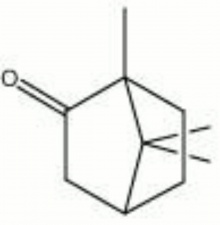Camphor
Description
An aromatic crystalline compound with a sweet smell. Camphor is obtained from the steam distillation of the leaves and wood of the camphor laurel tree, Cinnamomum camphora, native to southeast Asia. It forms a white waxy solid when purified by steam distillation and sublimation. Since the 1930s camphor has also been made synthetically. Camphor has been used as an insect repellent and as a vapor phase corrosion inhibitor for metals. It was also used in Celluloid as a plasticizer for Cellulose nitrate. Camphor sublimes slowly as room temperature; once vaporized it can react with and soften many plastics.
Synonyms and Related Terms
gum camphor; camphre (Fr.); 2-camphanone; 2-bornanone; Japan camphor; Formosa camphor; laurel camphor; synthetic camphor; Campher (Deut.); Kampfer(Deut.); camphre (Fr.); kamfer (Ned., Sven.); kamfora (Pol.); (Port.);
Other Properties
Rhombohedral crystals. Sublimes at room temperature. Soluble in ethanol, ether, chloroform, aniline, nitrobenzene, carbon disulfide, decalin, ligroin. Slightly soluble in water (0.12 g in 100 ml).
| Composition | C10H16O |
|---|---|
| CAS | 76-22-2 |
| Melting Point | 179.75 |
| Density | 0.992 |
| Molecular Weight | mol. wt. = 152.23 |
| Boiling Point | 204 |
Hazards and Safety
Combustible. Flash point = 64C
Contact may cause irritation or burns. Ingestion can cause nausea, vomiting, vertigo, convulsions and death.
Fisher Scientific: MSDS
Sources Checked for Data in Record
- Van Nostrand's Scientific Encyclopedia, Douglas M. Considine (ed.), Van Nostrand Reinhold, New York, 1976
- Random House, Webster's Encyclopedic Unabridged Dictionary of the English Language, Grammercy Book, New York, 1997
- MSDS Sheet Comment: Fisher Scientific 8/02/02: mp = 175-177 C, flash point = 64C
- Richard S. Lewis, Hawley's Condensed Chemical Dictionary, Van Nostrand Reinhold, New York, 10th ed., 1993
- The Merck Index, Martha Windholz (ed.), Merck Research Labs, Rahway NJ, 10th edition, 1983
- Encyclopedia Britannica, http://www.britannica.com Comment: "camphor" Encyclopædia Britannica [Accessed May 6, 2002].
- G.S.Brady, Materials Handbook, McGraw-Hill Book Co., New York, 1971 Comment: p. 134
- Matt Roberts, Don Etherington, Bookbinding and the Conservation of Books: a Dictionary of Descriptive Terminology, U.S. Government Printing Office, Washington DC, 1982
- Lynda A. Zycherman, J.Richard Schrock, A Guide to Museum Pest Control, FAIC and Association of Systematics Collections, Washington DC, 1988
- Pam Hatchfield, Pollutants in the Museum Environment, Archetype Press, London, 2002
- John S. Mills, Raymond White, The Organic Chemistry of Museum Objects, Butterworth Heineman, London, 2nd ed., 1994
- Susan E. Schur, Conservation Terminology: A review of Past & Current Nomenclature of Materials, Technology and Conservation, Spring (p.34-39); Summer (p.35-38); Fall (p.25-36), 1985
- The American Heritage Dictionary or Encarta, via Microsoft Bookshelf 98, Microsoft Corp., 1998
- Art and Architecture Thesaurus Online, http://www.getty.edu/research/tools/vocabulary/aat/, J. Paul Getty Trust, Los Angeles, 2000
